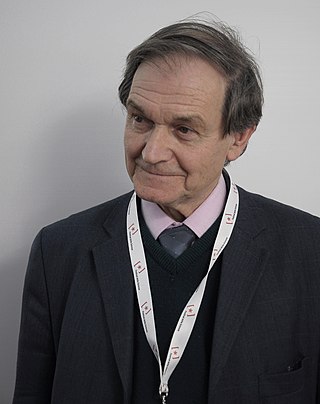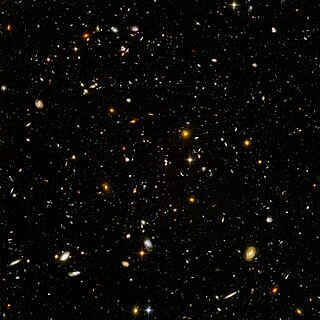The anthropic principle, also known as the "observation selection effect", is the hypothesis, first proposed in 1957 by Robert Dicke, that the range of possible observations that could be made about the universe is limited by the fact that observations could happen only in a universe capable of developing intelligent life. Proponents of the anthropic principle argue that it explains why the universe has the age and the fundamental physical constants necessary to accommodate conscious life, since if either had been different, no one would have been around to make observations. Anthropic reasoning is often used to deal with the idea that the universe seems to be finely tuned for the existence of life.
In mathematics, specifically set theory, the continuum hypothesis is a hypothesis about the possible sizes of infinite sets. It states that
there is no set whose cardinality is strictly between that of the integers and the real numbers,

The many-worlds interpretation (MWI) is a philosophical position about how the mathematics used in quantum mechanics relates to physical reality. It asserts that the universal wavefunction is objectively real, and that there is no wave function collapse. This implies that all possible outcomes of quantum measurements are physically realized in some "world" or universe. In contrast to some other interpretations, the evolution of reality as a whole in MWI is rigidly deterministic and local. Many-worlds is also called the relative state formulation or the Everett interpretation, after physicist Hugh Everett, who first proposed it in 1957. Bryce DeWitt popularized the formulation and named it many-worlds in the 1970s.

The multiverse is the hypothetical set of all universes. Together, these universes are presumed to comprise everything that exists: the entirety of space, time, matter, energy, information, and the physical laws and constants that describe them. The different universes within the multiverse are called "parallel universes", "flat universes", "other universes", "alternate universes", "multiple universes", "plane universes", "parent and child universes", "many universes", or "many worlds". One common assumption is that the multiverse is a "patchwork quilt of separate universes all bound by the same laws of physics."

Sir Roger Penrose is a British mathematician, mathematical physicist, philosopher of science and Nobel Laureate in Physics. He is Emeritus Rouse Ball Professor of Mathematics in the University of Oxford, an emeritus fellow of Wadham College, Oxford, and an honorary fellow of St John's College, Cambridge, and University College London.

A theory of everything (TOE), final theory, ultimate theory, unified field theory or master theory is a hypothetical, singular, all-encompassing, coherent theoretical framework of physics that fully explains and links together all aspects of the universe. Finding a theory of everything is one of the major unsolved problems in physics.

The universe is all of space and time and their contents. It comprises all of existence, any fundamental interaction, physical process and physical constant, and therefore all forms of energy and matter, and the structures they form, from sub-atomic particles to entire galaxies. Space and time, according to the prevailing cosmological theory of the Big Bang, emerged together 13.787±0.020 billion years ago, and the universe has been expanding ever since. Today the universe has expanded into an age and size that is physically only in parts observable as the observable universe, which is approximately 93 billion light-years in diameter at the present day, while the spatial size, if any, of the entire universe is unknown.
Reality is the sum or aggregate of all that is real or existent within the universe, as opposed to that which is only imaginary, nonexistent or nonactual. The term is also used to refer to the ontological status of things, indicating their existence. In physical terms, reality is the totality of a system, known and unknown.
"The Unreasonable Effectiveness of Mathematics in the Natural Sciences" is a 1960 article written by the physicist Eugene Wigner, published in Communication in Pure and Applied Mathematics. In it, Wigner observes that a theoretical physics's mathematical structure often points the way to further advances in that theory and to empirical predictions. Mathematical theories often have predictive power in describing nature.

Max Erik Tegmark is a Swedish-American physicist, machine learning researcher and author. He is best known for his book Life 3.0 about what the world might look like as artificial intelligence continues to improve. Tegmark is a professor at the Massachusetts Institute of Technology and the president of the Future of Life Institute.
Digital physics is a speculative idea that the universe can be conceived of as a vast, digital computation device, or as the output of a deterministic or probabilistic computer program. The hypothesis that the universe is a digital computer was proposed by Konrad Zuse in his 1969 book Rechnender Raum ("Calculating-space"). The term digital physics was coined in 1978 by Edward Fredkin, who later came to prefer the term digital philosophy. Fredkin encouraged the creation of a digital physics group at what was then MIT's Laboratory for Computer Science, with Tommaso Toffoli and Norman Margolus as primary figures.
In string theory, the string theory landscape is the collection of possible false vacua, together comprising a collective "landscape" of choices of parameters governing compactifications.
The free will theorem of John H. Conway and Simon B. Kochen states that if we have a free will in the sense that our choices are not a function of the past, then, subject to certain assumptions, so must some elementary particles. Conway and Kochen's paper was published in Foundations of Physics in 2006. In 2009, the authors published a stronger version of the theorem in the Notices of the American Mathematical Society. Later, in 2017, Kochen elaborated some details.

Shadows of the Mind: A Search for the Missing Science of Consciousness is a 1994 book by mathematical physicist Roger Penrose that serves as a followup to his 1989 book The Emperor's New Mind: Concerning Computers, Minds and The Laws of Physics.

The Boltzmann brain thought experiment suggests that it might be more likely for a single brain to spontaneously form in a void, complete with a memory of having existed in our universe, rather than for the entire universe to come about in the manner cosmologists think it actually did. Physicists use the Boltzmann brain thought experiment as a reductio ad absurdum argument for evaluating competing scientific theories.
There is a diversity of views that propose interpretations of quantum mechanics. They vary in how many physicists accept or reject them. An interpretation of quantum mechanics is a conceptual scheme that proposes to relate the mathematical formalism to the physical phenomena of interest. The present article is about those interpretations which, independently of their intrinsic value, remain today less known, or are simply less debated by the scientific community, for different reasons.
Einstein–Cartan–Evans theory or ECE theory was an attempted unified theory of physics proposed by the Welsh chemist and physicist Myron Wyn Evans, which claimed to unify general relativity, quantum mechanics and electromagnetism. The hypothesis was largely published in the journal Foundations of Physics Letters between 2003 and 2005. Several of Evans's central claims were later shown to be mathematically incorrect and, in 2008, the new editor of Foundations of Physics, Nobel laureate Gerard 't Hooft, published an editorial note effectively retracting the journal's support for the hypothesis.
In physics, Born reciprocity, also called reciprocal relativity or Born–Green reciprocity, is a principle set up by theoretical physicist Max Born that calls for a duality-symmetry among space and momentum. Born and his co-workers expanded his principle to a framework that is also known as reciprocity theory.

Our Mathematical Universe: My Quest for the Ultimate Nature of Reality is a 2014 nonfiction book by the Swedish-American cosmologist Max Tegmark. Written in popular science format, the book interweaves what a New York Times reviewer called "an informative survey of exciting recent developments in astrophysics and quantum theory" with Tegmark's mathematical universe hypothesis, which posits that reality is a mathematical structure. This mathematical nature of the universe, Tegmark argues, has important consequences for the way researchers should approach many questions of physics.

"Why is there anything at all?" or "why is there something rather than nothing?" is a question about the reason for basic existence which has been raised or commented on by a range of philosophers and physicists, including Gottfried Wilhelm Leibniz, Ludwig Wittgenstein, and Martin Heidegger, who called it "the fundamental question of metaphysics".









